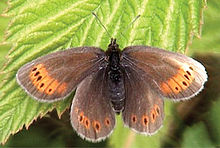| Raetzer's ringlet | |
|---|---|

| |
| Conservation status | |
 Vulnerable (IUCN 3.1) | |
| Scientific classification | |
| Domain: | Eukaryota |
| Kingdom: | Animalia |
| Phylum: | Arthropoda |
| Class: | Insecta |
| Order: | Lepidoptera |
| Family: | Nymphalidae |
| Genus: | Erebia |
| Species: | E. christi |
| Binomial name | |
| Erebia christi Rätzer, 1890 | |
The Raetzer's ringlet (Erebia christi) is a species of butterfly in the family Nymphalidae. It is found in Italy and Switzerland. Its natural habitat is temperate grassland. It is one of the rarest European butterflies, having not more than six or seven populations.

Description in Seitz
For a key to the terms used, see Glossary of entomology terms.E. christi Rätzer (36 c). This species comes nearest to cassiope, being however at least one-third larger. The forewing more elongate than in cassiope, apex and distal margin rounded, also in the hindwing, the apex of the latter being obtusely pointed in cassiope. The brown transverse band of the forewing is of even width and runs parallel with the distal margin, being sharply defined proximally and distally and separated by the veins into spots, usually 6. The 2. and 3. of these spots counted from the costal side are not prolonged both ways as is cassiope, but are of the same size as the others. In the upper spots there is a straight row of 3 or 4 black dots, of which the 2 middle ones are always larger than the others. The hindwing bears 4, more rarely 3, oval russet-yellow spots with ovate black dots, which in the female are sometimes prolonged to streaks. The underside of the forewing is russet-brown, being darker basally, the lighter band contrasting distinctly with the central area. Costal and distal margins brown-grey. Only the 2 central black dots are as large as above, while the others are either completely absent or are represented but by small black specks. The hindwing beneath violet-grey, with a darker dentate band, which is obsolete in the female, but distinct in the male. — The only locality so far known is the Laquin Valley at the southern Simplon-road below the village of Simplon. The flight-place is very limited, having only an extent of 5–600 m, consisting of grassy and flowery slopes covered with rocks and boulders. The butterfly is not abundant. Wheeler (1903) gives a short description.
References
- van Swaay, C.; Wynhoff, I.; Verovnik, R.; Wiemers, M.; López Munguira, M.; Maes, D.; Sasic, M.; Verstrael, T.; Warren, M.; Settele, J. (2010). "Erebia christi". IUCN Red List of Threatened Species. 2010: e.T39491A10232607. doi:10.2305/IUCN.UK.2010-1.RLTS.T39491A10232607.en. Retrieved 17 November 2021.
- Georg Eiffinger in Seitz, A. ed. Band 1: Abt. 1, Die Großschmetterlinge des palaearktischen Faunengebietes, Die palaearktischen Tagfalter, 1909, 379 Seiten, mit 89 kolorierten Tafeln (3470 Figuren)
 This article incorporates text from this source, which is in the public domain.
This article incorporates text from this source, which is in the public domain.
- Wheeler, George.The butterflies of Switzerland and the alps of central Europe. London: Elliot Stock, 1903. pdf
- C. Van Swaay; et al. (2012). "Dos and Don'ts for butterflies of the Habitats Directive of the European Union". Nature Conservation. 1: 73–153. doi:10.3897/natureconservation.1.2786.
External links
| Taxon identifiers | |
|---|---|
| Erebia christi |
|
This Satyrini article is a stub. You can help Misplaced Pages by expanding it. |